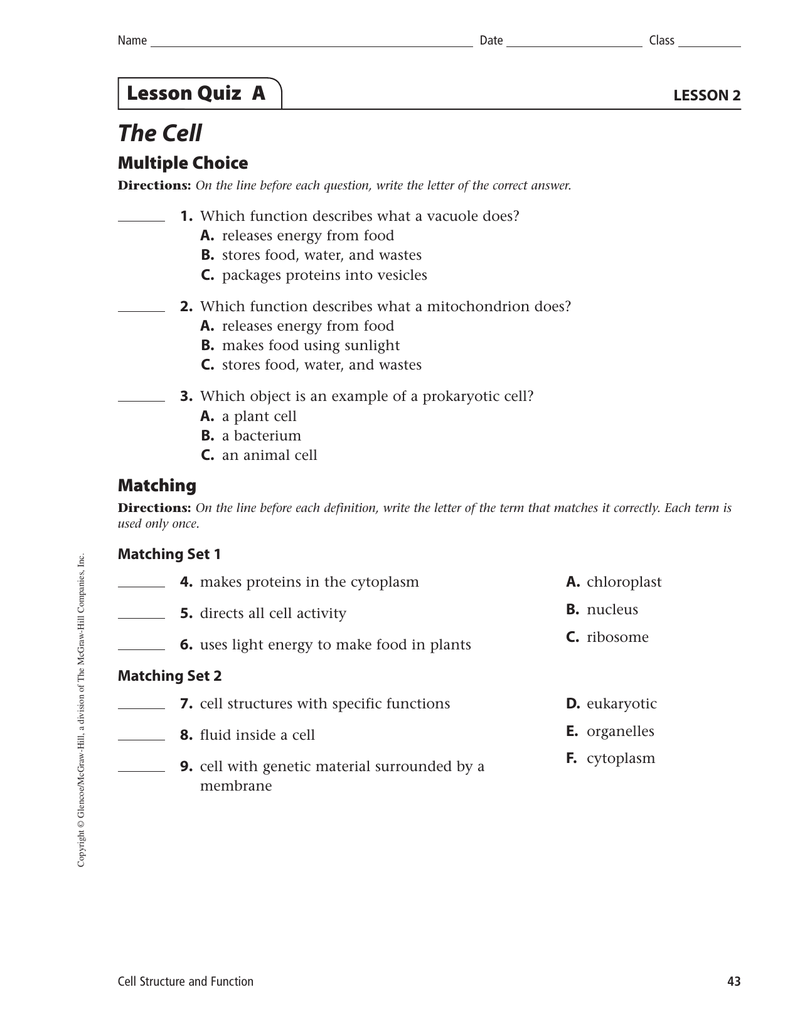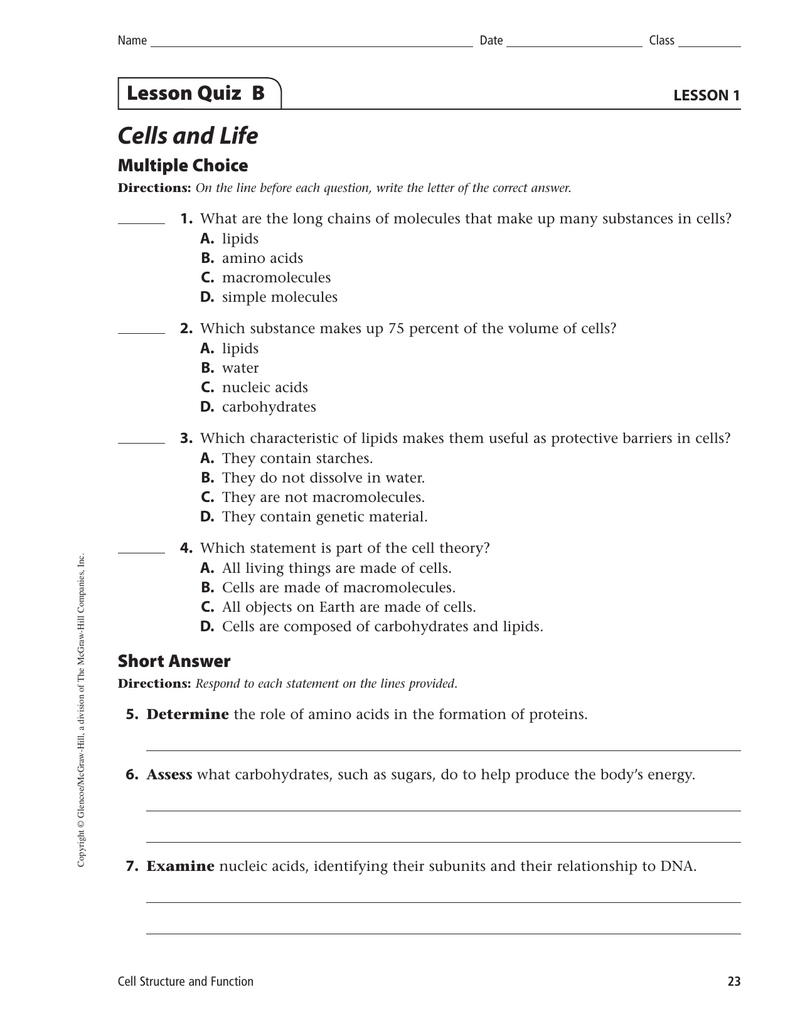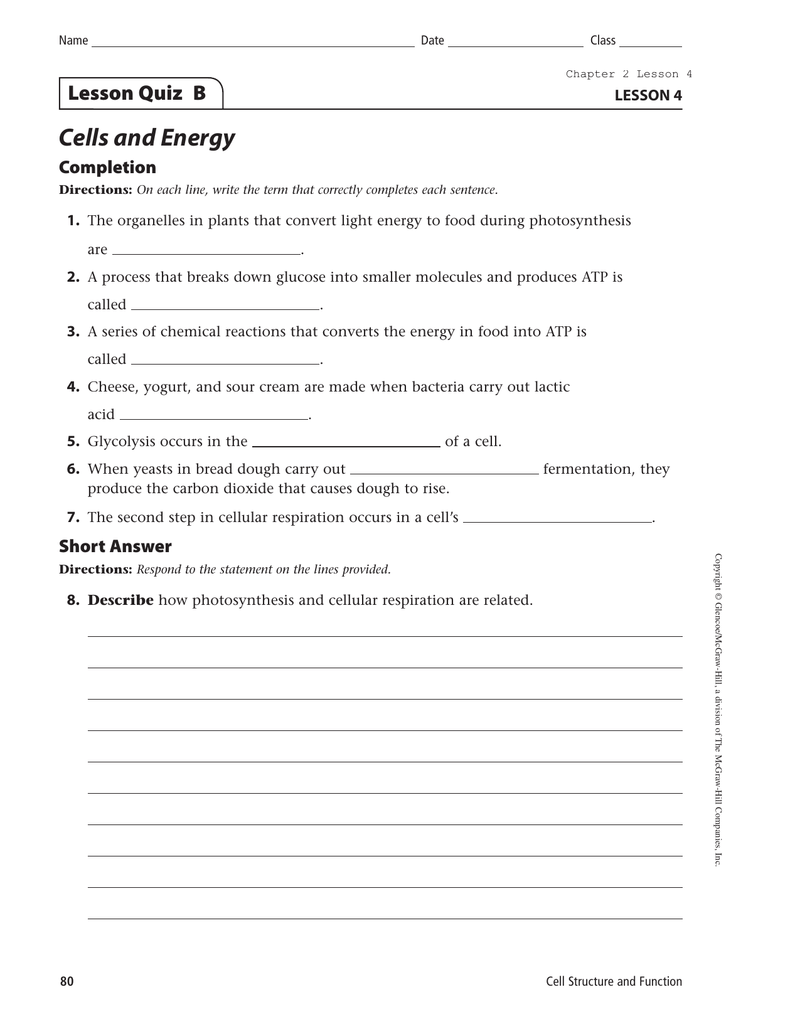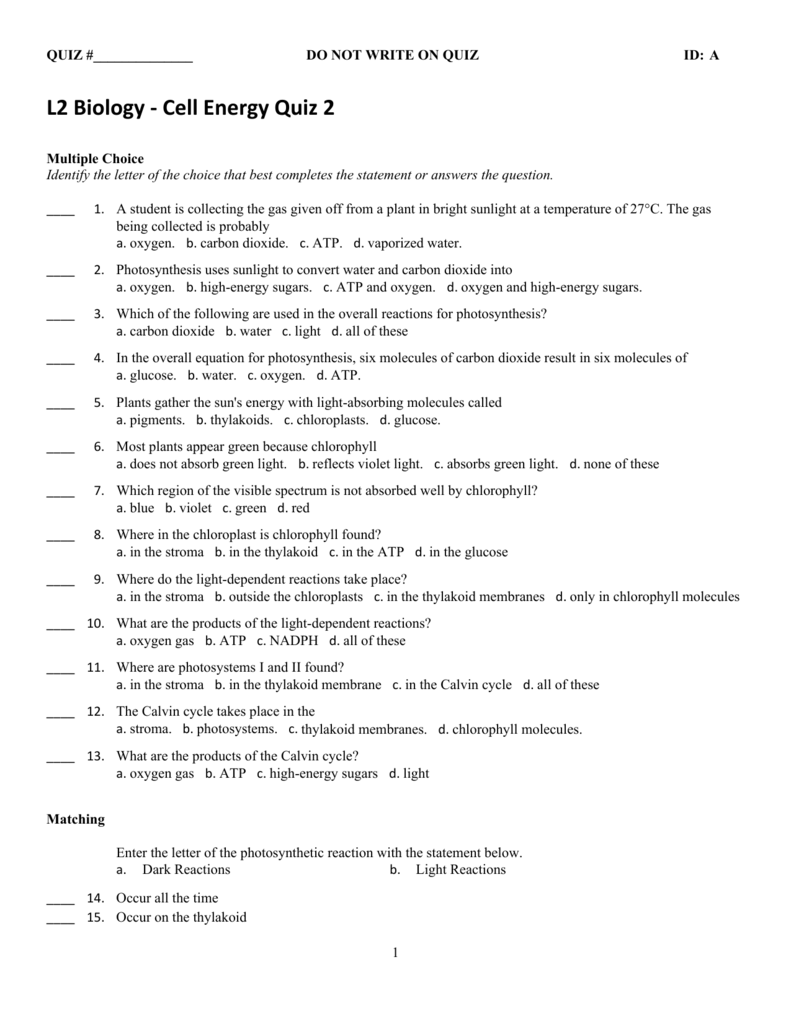Lesson Quiz a Cells and Energy
Cells and Energy Lesson 4 STUDY Flashcards Learn Write Spell Test PLAY Match Gravity Created by LindaCard Terms in this set 4 fermentation This is a reaction used by cells to obtain. The energy carried by ATP is released when a phosphate group is removed from the molecule.

The Cell Lesson Quiz A Multiple Choice Lesson 2
Chemical reactions occur in the cells cytoplasm.

. Up to 24 cash back A. Cells can get energy from food when they cannot get oxygen through photosynthesis. This quiz will ask you some essential points of the topic lets see how well do you know.
Water and carbon dioxide. Magnification 2500 Connect The cells of all organismsfrom algae to whales. A process that breaks down glucose into smaller molecules and produces ATP is called.
Energy is a quantitative property that can be transferred from objects to objects can take forms but cannot be created or destroyed. They always come from pre-existing cells. ATP has three phosphate groups but the bond holding the third phosphate group is unstable and is very easily broken.
A series of chemical reactions that converts the energy in food into ATP is called. Up to 24 cash back Lesson Quiz B Date Class LESSON 1 Sexual Reproduction and Meiosis Completion Directions. Cell Shape and Movement 1.
This worksheet and quiz let you practice the following skills. The process by which a cell uses energy to surround a particle and enclose the particle in a vesicle to bring the particle into the cell is. All things need energy to survive.
During one diploid cell divides to make four haploid cells. Photosynthesis occurs in the mitochondria of plants. Plants get energy from food they make for themselves.
Cells and Energy A. Reading comprehension - ensure that you draw the most important information from the. A process by which glucose is broken down into smaller molecules is called glycolysis.
The is a flexible covering that protects the inside of a cell from the environment outside. The first step of cellular respiration called glycolysis occurs in the of all cells. The overall purpose of cellular respiration is to transform energy stored in molecules of glucose to energy stored in molecules of __________.
The diffusion of water through a semi-permeable membrane is called _______. All liv-ing organisms must be able to pro-duce energy from the environment in which they live store energy for future use and use energy in a con-trolled manner. Online Science Videos and Lessons For K-8.
All cells have a protective plasma membrane but some cells also have an additional. A reaction that eukaryotic and prokaryotic cells can use to obtain energy from food when oxygen levels are low Photosynthesis. That is released during to make food energy and release oxygen.
VISUAL VOCAB EEEE EE adenosine triphosphate tri3 EE adenosine diphosphate FIGURE 41 All cells including di2 plant cells use ATP for energy. Small molecules enter mitochondria. In order to acquire glucose some animals eat plants.
The organelles in plants that convert light energy to food during photosynthesis are. Energy for a cell is stored in. Energy for a flashlight is stored in a battery.
When an organism eats plant material it takes in energy. Active transport cell division movement of. Which of the following are true of the Krebs cycle check all that apply.
Work and the need for energy Youve learned about several cell processes that require energy. Fermentation makes less ATP than. Complete the sentences to tell how cells use energy.
Ad Includes 5E Lesson Plans Reading Material Quiz Games DIY Activities More. Up to 24 cash back Lesson Outline LESSON 4 Cells and Energy A. Understandings Students will understand that.
Cell Energy Energy is essential to life. A reaction that eukaryotic and prokaryotic cells can use to obtain energy from food when oxygen levels are low. Animals are able to store glucose.
A cell membrane is mostly made of phospholipids and. Other animals eat. Up to 24 cash back organelles in plant cells that convert light energy into food.
Then add the information to the flowchart to show the steps in cellular respiration. A simple definition of the energy- the capacity to do work move an object by some application of force or heating an object. ADP is a lower-energy molecule that can be converted into ATP.
SCI712E Compare the functions of a cell to the functions of organisms such as waste removal. Lesson Outline for Teaching Lesson 4. Is the joining of an egg cell and a sperm cell.
SCI712F Recognize that according to cell theory all organisms are composed of cells and cells carry on similar functions such as extracting energy from food to sustain life. On each line write the term that correctly completes each sentence. Cells use ATP for functions such as building molecules and moving materials by active transport.
Put the following steps in the correct order from 1 to 7. The production of an offspring that results when the genetic materials from two. Cellular respiration is a series of chemical reactions that convert the energy in food molecules into a usable form of energy called ATP.
The moment of particles against a concentration gradient and requires the cell to use energy is called __________. The first step of cellular respiration called glycolysis occurs in the cytoplasm of all cells. A term for the chemical reactions that convert the energy in food into energy the cell can use is cellular respiration.
The Cell A. Cells are the basic units of life of all organisms. A series of chemical reactions that convert light energy water H2O and carbon dioxide CO2 into the food-energy molecule glucose and give off oxygen O2.
Carries chemical energy that cells can use. Name Date Class Chapter 2 Lesson 4 Content Practice A LESSON 4 Cells and Energy Directions. Up to 24 cash back ATP transfers energy to cell processes.
Is a series of chemical reactions that convert the energy in food molecules into a usable form of energy called ATP. Animals get energy from. All living things need energy to survive.
A cell is made of different that work together and keep a cell alive.

Cells And Energy Lesson Quiz B Completion Lesson 4

Comments
Post a Comment